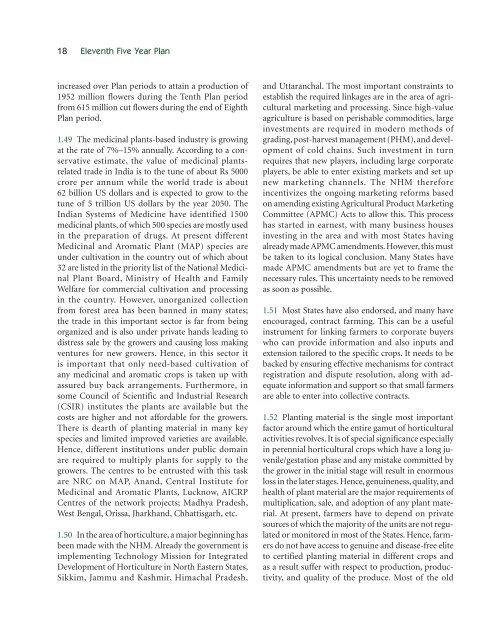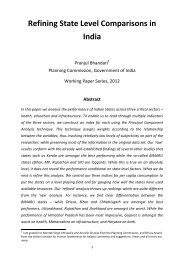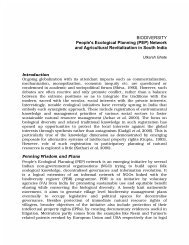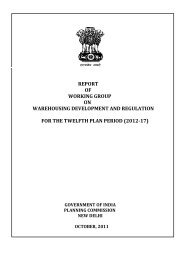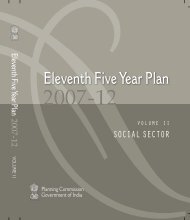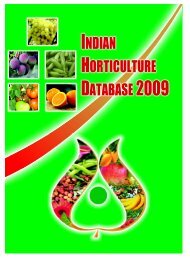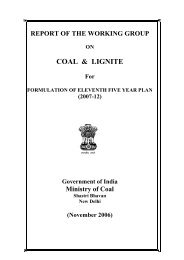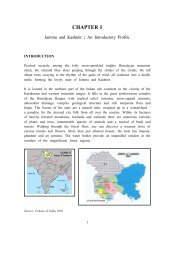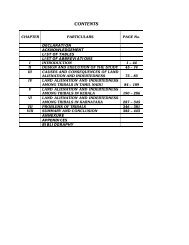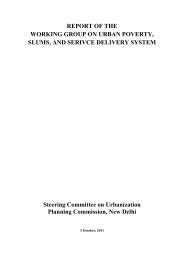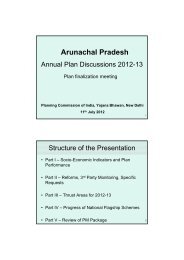Eleventh Five Year Plan - of Planning Commission
Eleventh Five Year Plan - of Planning Commission
Eleventh Five Year Plan - of Planning Commission
You also want an ePaper? Increase the reach of your titles
YUMPU automatically turns print PDFs into web optimized ePapers that Google loves.
18 <strong>Eleventh</strong> <strong>Five</strong> <strong>Year</strong> <strong>Plan</strong><br />
increased over <strong>Plan</strong> periods to attain a production <strong>of</strong><br />
1952 million flowers during the Tenth <strong>Plan</strong> period<br />
from 615 million cut flowers during the end <strong>of</strong> Eighth<br />
<strong>Plan</strong> period.<br />
1.49 The medicinal plants-based industry is growing<br />
at the rate <strong>of</strong> 7%–15% annually. According to a conservative<br />
estimate, the value <strong>of</strong> medicinal plantsrelated<br />
trade in India is to the tune <strong>of</strong> about Rs 5000<br />
crore per annum while the world trade is about<br />
62 billion US dollars and is expected to grow to the<br />
tune <strong>of</strong> 5 trillion US dollars by the year 2050. The<br />
Indian Systems <strong>of</strong> Medicine have identified 1500<br />
medicinal plants, <strong>of</strong> which 500 species are mostly used<br />
in the preparation <strong>of</strong> drugs. At present different<br />
Medicinal and Aromatic <strong>Plan</strong>t (MAP) species are<br />
under cultivation in the country out <strong>of</strong> which about<br />
32 are listed in the priority list <strong>of</strong> the National Medicinal<br />
<strong>Plan</strong>t Board, Ministry <strong>of</strong> Health and Family<br />
Welfare for commercial cultivation and processing<br />
in the country. However, unorganized collection<br />
from forest area has been banned in many states;<br />
the trade in this important sector is far from being<br />
organized and is also under private hands leading to<br />
distress sale by the growers and causing loss making<br />
ventures for new growers. Hence, in this sector it<br />
is important that only need-based cultivation <strong>of</strong><br />
any medicinal and aromatic crops is taken up with<br />
assured buy back arrangements. Furthermore, in<br />
some Council <strong>of</strong> Scientific and Industrial Research<br />
(CSIR) institutes the plants are available but the<br />
costs are higher and not affordable for the growers.<br />
There is dearth <strong>of</strong> planting material in many key<br />
species and limited improved varieties are available.<br />
Hence, different institutions under public domain<br />
are required to multiply plants for supply to the<br />
growers. The centres to be entrusted with this task<br />
are NRC on MAP, Anand, Central Institute for<br />
Medicinal and Aromatic <strong>Plan</strong>ts, Lucknow, AICRP<br />
Centres <strong>of</strong> the network projects; Madhya Pradesh,<br />
West Bengal, Orissa, Jharkhand, Chhattisgarh, etc.<br />
1.50 In the area <strong>of</strong> horticulture, a major beginning has<br />
been made with the NHM. Already the government is<br />
implementing Technology Mission for Integrated<br />
Development <strong>of</strong> Horticulture in North Eastern States,<br />
Sikkim, Jammu and Kashmir, Himachal Pradesh,<br />
and Uttaranchal. The most important constraints to<br />
establish the required linkages are in the area <strong>of</strong> agricultural<br />
marketing and processing. Since high-value<br />
agriculture is based on perishable commodities, large<br />
investments are required in modern methods <strong>of</strong><br />
grading, post-harvest management (PHM), and development<br />
<strong>of</strong> cold chains. Such investment in turn<br />
requires that new players, including large corporate<br />
players, be able to enter existing markets and set up<br />
new marketing channels. The NHM therefore<br />
incentivizes the ongoing marketing reforms based<br />
on amending existing Agricultural Product Marketing<br />
Committee (APMC) Acts to allow this. This process<br />
has started in earnest, with many business houses<br />
investing in the area and with most States having<br />
already made APMC amendments. However, this must<br />
be taken to its logical conclusion. Many States have<br />
made APMC amendments but are yet to frame the<br />
necessary rules. This uncertainty needs to be removed<br />
as soon as possible.<br />
1.51 Most States have also endorsed, and many have<br />
encouraged, contract farming. This can be a useful<br />
instrument for linking farmers to corporate buyers<br />
who can provide information and also inputs and<br />
extension tailored to the specific crops. It needs to be<br />
backed by ensuring effective mechanisms for contract<br />
registration and dispute resolution, along with adequate<br />
information and support so that small farmers<br />
are able to enter into collective contracts.<br />
1.52 <strong>Plan</strong>ting material is the single most important<br />
factor around which the entire gamut <strong>of</strong> horticultural<br />
activities revolves. It is <strong>of</strong> special significance especially<br />
in perennial horticultural crops which have a long juvenile/gestation<br />
phase and any mistake committed by<br />
the grower in the initial stage will result in enormous<br />
loss in the later stages. Hence, genuineness, quality, and<br />
health <strong>of</strong> plant material are the major requirements <strong>of</strong><br />
multiplication, sale, and adoption <strong>of</strong> any plant material.<br />
At present, farmers have to depend on private<br />
sources <strong>of</strong> which the majority <strong>of</strong> the units are not regulated<br />
or monitored in most <strong>of</strong> the States. Hence, farmers<br />
do not have access to genuine and disease-free elite<br />
to certified planting material in different crops and<br />
as a result suffer with respect to production, productivity,<br />
and quality <strong>of</strong> the produce. Most <strong>of</strong> the old


